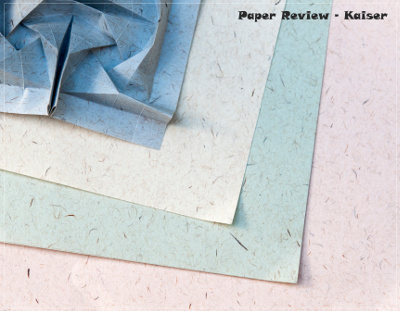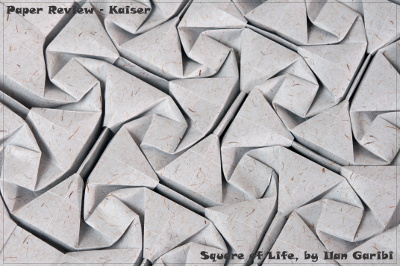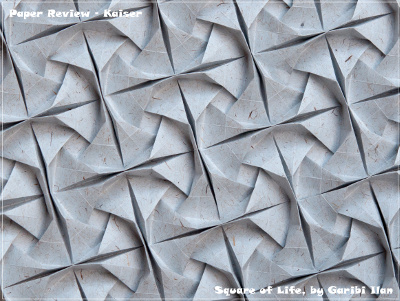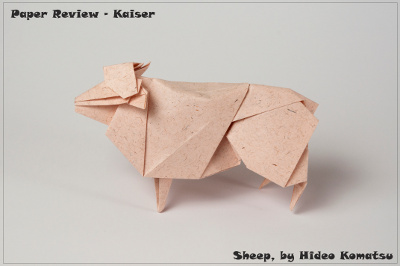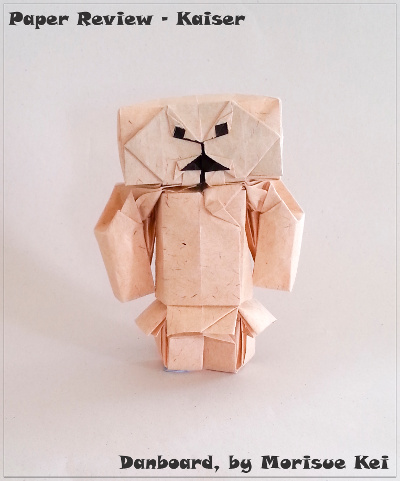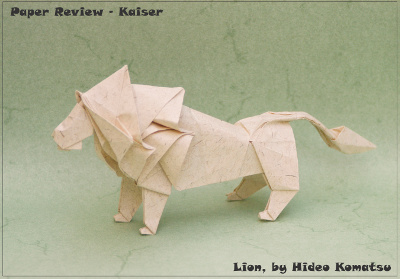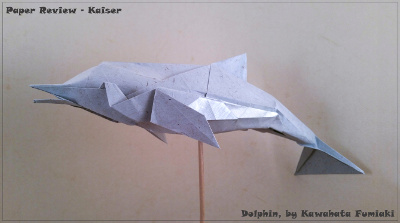Look and Feel
Model Suitability (out of 10):
Attributes (out of 10):
It's not easy to get Japanese papers; the sites selling it are usually not in English, most of us cannot type the names into search engines like Google, and if you do manage to find what you look for, shipping costs are often prohibitively high. This is why whenever I get the chance to buy Japanese paper in a shop, I do.
I found グレートカイゼル (Kaiser) at the JOAS convention a year ago, and it is one of the best papers I bought. Nicolas Terry, who also sells it, prefers to call it Stark. Just like the other Japanese papers we reviewed, it is made and distributed by Takeo.
By far, it is one of the most beautiful papers I have, but does it fold just as nice as it looks? As we could not find it cut down to even 15cm squares, it's probably not destined to be used for traditional, action, or modular models. So we skipped these sections this time. For the rest, read on!
Properties
- Thickness: We measured a weight of 86 gsm, which is reasonably close to the stated weight of 80 gsm. It has a thickness of 118 microns. For comparison, Tant weighs 80 gsm and is 127 microns thick. So it is thinner, yet heavier, meaning Kaiser is denser than Tant. Its thickness ratio is 0.72, right between Tant (0.625) and Elephant Hide (0.815).
- Sizes: Nicolas Terry sells squares with a side length of 24cm (9.5in), 35cm (13.8in), 50cm (19.7in), and 70cm (27.5in). We also found a shop that sells it in 54cm by 39 cm sheets.
- Colors: The shops we found sell up to 6 colors, all pastel shades: light blue, off-white, light green, light pink, as well as ivory and gray (not shown in the picture).
- Paper Coloring or Colorability: I used metallic Folk Art grey color. The paper hardly curled. After drying, which took less than five minutes, the paper had exactly the same size as before. None of the color seeped to the other side. The only downside is that the texture of the paper almost completely disappears.
- Texture: The paper surface is relatively smooth, you can feel a slight difference between front and reverse. Many short fibers float all over the paper. Most of them are quite light, but there are also some darker ones.
- Photogenic: The paper photographs absolutely fabulously. As the paper has a matt finish, you can use a flash without fear of shine. The texture shows up very clearly.
- Aging and Wear and Tear: Kaiser scored 427 and 550 in the tear machine. For comparison, Elephant Hide practically doubled that, scoring 1130. While folding a tessellation, I stretched the paper and got a tear that stopped only at the next crease. Still, that was the only tear we had during folding. 7 out of 10.
- Memory: High. Creases are sharp and evident. 8.5 out of 10.
- Forgiveness: Very high - the first crease breaks the paper in a way that makes reversing it easy. 9 out of 10.
- Tensile Strength: We refer here to the maximum stress the paper can undergo while being stretched or pulled. With the grain, the paper endured 11.5kg, stretching by 4.66 mm before tearing. In strong contrast, against the grain, the paper tore at 3.9 kg already, stretching by 4 mm. 7 out of 10.
- Bending Resistance: This section rates the amount of force you need to apply to get a sharp crease and how strong the paper is while being curved. The results, 129 and 59 are a little better than those we measured for Tant (104/54), which has a similar paper weight. 8 out of 10.
- Price group: Expensive – think thoroughly before using – for a best friend's wedding gift.
- Where to buy:
- origami-shop.com: 70cm, 50cm, 35cm, 24cm squares
- origamishop.us: 70cm, 50cm, 35cm squares
- origamihouse.jp: 35cm squares
- kamisenmonten.jp (white, pink, blue, green, ivory, gray): 54cm by 39cm
Test results
Tessellation
Square of Life tessellation by Ilan Garibi, 35×35cm
Well, this has never happened before! I had to fold this model twice, because my first impression was completely opposite of what the other folders experienced.
When folding the grid for the first model, I didn't like the paper's resistance when reversing a crease. The paper did't break easily, and I got the sense it would not stay on the crease. Yet, it did. Folding with the grain this was even more evident, making the paper as if it were plastic-coated.
On my second try I had no such problems. The paper folded well, and the fold lines were visible. I could reverse a fold effortlessly. The 32-grid was finished really quickly, same with the precreasing.
The difference in my experience when collapsing the model was even more pronounced. The first time round, the creases were not springy enough. The paper is under a lot of stress when folding this model, and instead of breaking on the crease line, the paper just bent where the force was the strongest. The collapse required a lot of shaping with a bone folder, pushing every crease to its place. The final model isn't as clean as I thought it would be. Plus, the pressure from the extra pushing and stretching I needed, caused a tear along a fold line perpendicular to the edge. Once I also pushed the paper a bit too strongly, piercing it.
On my second try, it felt like I was using a different type of paper. The paper was crisp and snapped into place much more easily. I could collapse it quickly and was very happy with the result.
My best guess is that the different folding experience came from the weather conditions. On my first fold the air was more humid and the paper puffed up. This made reversing creases harder, as a fold does not break the fibers. The second time I folded this model, it was very hot and dry, so the paper stayed nice and crisp.
3D models
Sheep by Hideo Komatsu, 35×35cm
My first impression is gorgeous. It's easy to fold with high accuracy. Folds are done with ease; the paper is not really thin, but it behaves like it is. You can align a layer with the one below exactly, even when there are multiple layers. The paper surface is very smooth and resists the fold, a little like plastic. It is more evident when you try to reverse a fold. I had to move slowly and enforce the reversed crease in step 36, where you need to push in side and reverse the far layer. Finalising the model, I was very pleased with both the process and the result.
Danboard by Morisue Kei, 35×35cm
Guy Loel folded this model.
The Danborad was folded by Ynon Toledano.
As this is a model with a color change effect, I colored the paper. I noticed that the two sides are slightly different and the rougher side is much more suitable for coloring.
The box-pleating requires a lot of precreasing. The paper responded well. It takes creases nicely, but it is a little hard to reverse the folds. While I was shaping the details, I neededd to work more than usual, but I am very happy with the result!
Lion by Hideo Komatsu, 35×35cm
The Lion was folded by Elad Goshen.
The immediate feeling I got when I touched the paper was that it's like Elephant Hide, just thinner! As such, you get the benefits of folding complex models without the extra effort Elephant Hide requires to achieve small details such as feet, ears, etc.
The folding process was fun and went smoothly, I achieved sharp and accurate creases each time. Creases were visible and easy to follow. The paper has good memory, making the reverse folds and sinks relatively easy and accurate. Shaping the model was a bit harder. The 3D shaping did not hold and I had to use wet folding to achieve the desired shape.
Overall the effort was worthwhile, the result is beautiful and the unique texture of the paper gives the final model an impressive and appealing appearance.
Dolphin by Kawahata Fumiaki, 35×35cm
The Dolphin was folded by Guy Loel.
I used acrylic paint to color the reverse of the paper pearl white for the dolphin's belly. The color didn't seep through to the other side, and the paper did not warp at all. To me, it's not a thin paper, and it feels very strong, comparatively. This model has no high pressure points, so I couldn't verify my feeling, though. I believe it's a paper that doesn't turn soft easily. Even better, the strength and durability do not come with the too common price tag of thickness. The paper is easy to fold. And although I didn't feel the paper snap into place, reversing was still easy. Finally, I love the texture, and the fact it keeps the shape easily.
Final verdict
This paper is truly a pleasant surprise. All of us agreed it is an excellent paper. As it's relatively thin, it is suitable for folding complex models. When comparing it to Elephant Hide it falls just a little short, which is high praise indeed. We loved folding 3D models with it, and we all liked the way you can shape it. For tessellations it is very suitable; it does not excel in snappiness, but, again, its thickness does allow a lot of maneuvering. You may wonder if a tessellation can benefit from a textured paper, it is a matter of personal taste.
The color palette is very limited, but the paper takes color very easily. Importantly, there is no distortion and the color does not seep to the other side. However, it does cover up the texture, which is a shame. For color change models it's a good option, still.
Why should you buy it?
This paper gives you amazing texture without the need to compromise. It folds well, it looks great, it's not as thick as Elephant Hide, and it is almost as good.
Bottom line: beauty and character!

